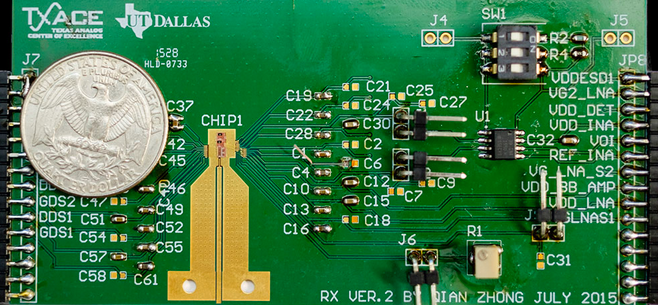A low-cost ‘electronic nose’ spectrometer for home health diagnosis
June 16, 2016

Current experimental design of transmitter radio-frequency front end for a rotational spectrometer. Using integrated circuits (such as the one below “CHIP1”) in an electronic nose promises to make the future device more affordable. (credit: UT Dallas)
UT Dallas researchers have designed an affordable “electronic nose” radio-frequency front end for a rotational spectrometer — used for detecting chemical molecules in human breath for health diagnosis.
Current breath-analysis devices are bulky and too costly for commercial use, said Kenneth O, PhD, a principal investigator of the effort and director of Texas Analog Center of Excellence (TxACE). Instead, the researchers used CMOS integrated circuits technology, which promises to make the device compact and affordable.
A rotational spectrometer generates and transmits electromagnetic waves over a wide range of frequencies, and analyzes how the waves are attenuated (absorbed) to determine what chemicals are present, as well as their concentrations in a sample. The system can detect low levels of chemicals present in human breath.
A breath test contains information about practically every part of a human body, but an electronic nose can detect gas molecules with more specificity and sensitivity than breathalyzers, which can confuse acetone for ethanol (the active ingredient of alcoholic drinks) in the breath, for example. This is important for patients with Type 1 diabetes, who have high concentrations of acetone in their breath.
The current research focuses on the design of a 200–280 GHz transmitter radio-frequency front end.
Future home use predicted
The researchers envision that the CMOS-based device will first be used in industrial settings, and then in doctors’ offices and hospitals. As the technology matures, the devices could be used in homes. Dr. O said the need for blood work and gastrointestinal tests, for example, could be reduced, and diseases could be detected earlier, lowering the costs of health care.
The researchers plan to have a prototype programmable electronic nose available for beta testing in early 2018.
The research is supported by the Semiconductor Research Corporation, Texas Instruments, and Samsung Global Research Outreach. The research team includes members at UT Southwestern, Ohio State University, and Wright State University.
The research was presented Wednesday in an open-access paperat the 2016 IEEE Symposia on VLSI Technology and Circuits in Honolulu, Hawaii.